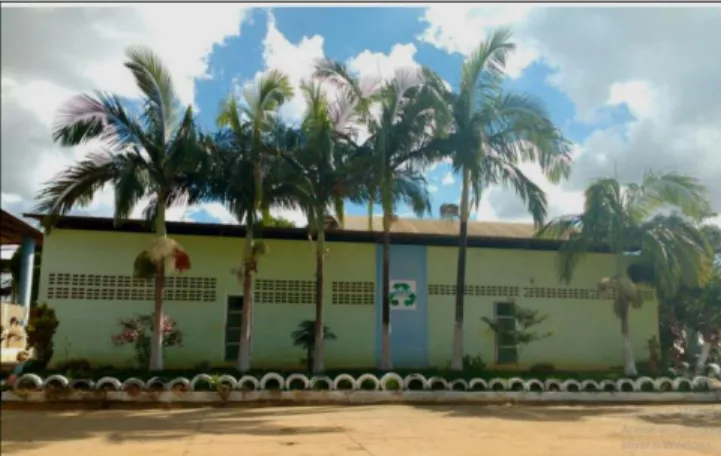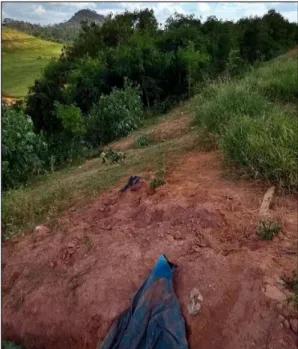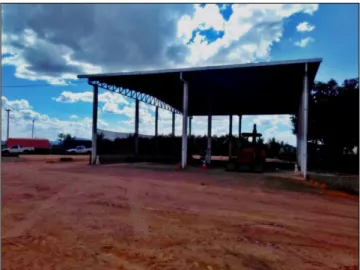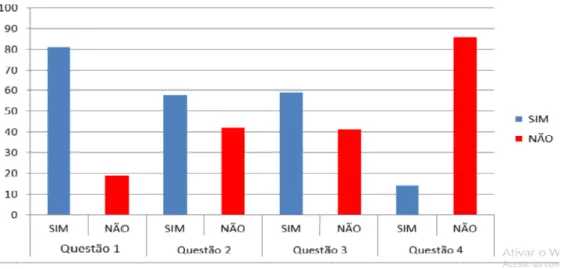Braz. J. of Develop., Curitiba, v. 5, n. 7, p. 10094-10104 jul. 2019 ISSN 2525-8761
Environmental education in São Gabriel da Palha, Espírito Santo, Brazil:
An analysis of the municipal solid waste management
Educação ambiental em São Gabriel da Palha, Espírito Santo, Brazil:
Uma análise da gestão municipal de resíduos sólidos
DOI:10.34117/bjdv5n7-173
Recebimento dos originais: 14/06/2019 Aceitação para publicação: 23/07/2019
Marcos Vinícius Perdoná
Bacharel em Geologia pela Universidade Federal do Espírito Santo Instituição: Universidade Federal do Espírito Santo – Campus Alegre Endereço: Alto Universitário s/n, Guararema,
Alegre – ES, Brasil
E-mail: mvperdona95@gmail.com Jaisa Barbieri de Mello
Graduanda em Geologia pela Universidade Federal do Espírito Santo Instituição: Universidade Federal do Espírito Santo – Campus Alegre Endereço: Alto Universitário s/n,
Guararema, Alegre – ES, Brasil E-mail: jaisabm17@gmail.com
Eder Carlos Moreira
Doutor em Geociências pela Universidade Federal do Rio Grande do Sul Instituição: Universidade Federal do Espírito Santo – Campus Alegre Endereço: Alto
Universitário s/n, Guararema, Alegre – ES, Brasil E-mail: edercmoreira@hotmail.com
Marcos Moulim da Paschoa
Graduando em Geologia pela Universidade Federal do Espírito Santo Instituição: Universidade Federal do Espírito Santo – Campus Alegre Endereço: Alto Universitário s/n,
Guararema, Alegre – ES, Brasil E-mail: marcosmoulin96@gmail.com
Vitor Roberto Schettino
Bacharel em Geologia pela Universidade Federal do Espírito Santo Instituição: Universidade Federal do Espírito Santo – Campus Alegre Endereço: Alto Universitário s/n, Guararema,
Alegre – ES, Brasil
E-mail: schettino.vitor@gmail.com Luiz Felipe Lempê
Graduando em Geologia pela Universidade Federal do Espírito Santo Instituição: Universidade Federal do Espírito Santo – Campus Alegre Endereço: Alto Universitário s/n,
Guararema, Alegre – ES, Brasil E-mail: luizfelipelempe@live.com
Braz. J. of Develop., Curitiba, v. 5, n. 7, p. 10094-10104 jul. 2019 ISSN 2525-8761 ABSTRACT
Due to the creation of Law No.12,305/2010, responsible for establishing the National Policy on Solid Waste, the existence of open dumps in Brazil came into question, since it became prohibited, which consequently brought the need to change the form of solid waste management in the country. From this perspective, the Association of Recyclable Materials Collectors (ASCAT) was established with the responsibility for carrying out various activities with waste. In the municipality of São Gabriel da Palha, the ASCAT was installed in the former dependencies of the open dump. With the enactment of Law No. 12,305/2010, the site underwent some changes, and the solid waste was destined for trenches that were later grounded. However, it can be seen from a street-based approach, that a significant part of the population believes that ASCAT still works on an open dump. In this way, this article proposes to present a synthesis about the reasons that cause the lack of knowledge of the citizens on subjects related to the correct destination of garbage in the municipality itself, as well as a presentation of the work of ASCAT and, finally, a study of the area where the waste was dumped.
Keywords - Solid waste, sustainable development, recycling RESUMO
Devido à criação da Lei nº 12.305/2010, responsável pelo estabelecimento da Política Nacional de Resíduos Sólidos, a existência de lixões no Brasil foi questionada, pois passou a ser proibida, o que consequentemente trouxe a necessidade de mudança na forma de resíduos sólidos. gestão no país. Nessa perspectiva, a Associação dos Catadores de Materiais Recicláveis (ASCAT) foi criada com a responsabilidade de realizar diversas atividades com resíduos. No município de São Gabriel da Palha, o ASCAT foi instalado nas antigas dependências do lixão aberto. Com a promulgação da Lei nº 12.305/2010, o local sofreu algumas alterações, e os resíduos sólidos foram destinados a trincheiras que foram posteriormente aterradas. No entanto, pode ser visto a partir de uma abordagem baseada na rua, que uma parte significativa da população acredita que o ASCAT ainda funciona em um lixão aberto. Desta forma, este artigo propõe apresentar uma síntese sobre os motivos que provocam a falta de conhecimento dos cidadãos sobre assuntos relacionados ao destino correto do lixo no próprio município, bem como uma apresentação do trabalho do ASCAT e, por fim um estudo da área onde os resíduos foram despejados.
Palavras-chave – Resíduo sólidos, desenvolvimento sustentável, reciclagem 1 INTRODUCTION
The concern about solid waste disposal in Brazil, has never been in such evidence as in the last few years, largely due to the fact of the Law No. 12,305/2010 enactment, which was responsible for establishing the National Policy on Solid Waste. Since then, by means of this law, it was determined the closure of open dumps and the construction and operation of sanitary landfills, becoming more clear the responsilibity of each member of the productive chain for their own solid waste.
Braz. J. of Develop., Curitiba, v. 5, n. 7, p. 10094-10104 jul. 2019 ISSN 2525-8761 The National Policy on Solid Waste anticipates that the waste must be collected for future use, while the refuse must be sent to sanitary landfills, where they will be disposed correctly. Therefore, the correct definition of these terms is required for the understanding of the environmental topics and for the society to perform its role in the community where each one lives.
According to BRASIL (2010), the term “waste” refers to the material, substance, object or goods disposed by human activities in society, whose final destination must proceed in solid or semi-solid state, as well as gases in containers and liquids whose particular characteristics make it impossible to discharge them in public sewer networks and water bodies, or require for this purpose, economically and technically unviable solutions in comparison to other better available technologies. And the term “refuse” is used to refers to the materials that in case of exhausted all possibilities of reuse by technological processes previously known and financially accessible and, if there is no other alternative, are destined to locations that does not affect the environmental characteristics of the region.
The municipality of São Gabriel da Palha, State of Espírito Santo, Brazil, as well as the rest of the country, had to organize itself to comply with the requirements of Law No. 12,305/2010. Before that, the disposal of solid waste was carried out without any concern about environmental liabilities, and it was destined to areas without any preparation to receive them, setting an open dump. With the advent of the National Policy on Solid Waste, the old dumps were modified and the solid wastes were landed by the trench method of landfilling. And was created the Association of Recyclable Materials Collectors (ASCAT) in 2014, which is responsible to carrying out processes such as sorting and pressing the waste in that same place.
The existence of specific legislation that determines the extinguishment of open dumps in Brazil is quite recent. According to BROLLO & SILVA (2001), most european countries, had already implemented this law for at least the past 40 years, and this fact shows how late Brazil is about solid waste management.
As the National Policy on Solid Waste was only created in 2010, it is to be expected that much of the population does not totally understand such terms as ”solid wastes” and “refuses”, which directly influences its final disposal and consequently interferes negatively with the idea of reverse logistics, defined by BRASIL (2010), as the mechanism of:
(...) economic and social development characterized by a set of actions, procedures and means that seek to make feasible the collection and restitution of solid waste in the sector production
Braz. J. of Develop., Curitiba, v. 5, n. 7, p. 10094-10104 jul. 2019 ISSN 2525-8761 cycle or in another, or any other means that makes the destination environmentally appropriate (BRASIL, 2010).
In this context, it is necessary to raise awareness of the population, be it through media vehicles such as radio and TV or even a street approach. This approach has been undertaken and the results obtained will be discussed later in this article.
2 MATERIALS AND METHODS
The elaboration of this paper became possible after the division of the works in stages, each one with its main objective. Initially, a bibliographical research was done about previous studies with the objective of understanding the themes related to the National Policy on Solid Waste, as well as the concepts directed to the Environmental Geology area.
Then a visit was made to ASCAT’s installations whose purpose was to obtain relevant information on the activities carried out by the association, from the collect of household waste to sorting, weighing, pressing and their sale. At this stage of the work, it was also possible to know the old waste disposal area of São Gabriel da Palha, as well as the transshipment station, where the transport of the wastes to Colatina currently takes place. According to an oral communication with the São Gabriel da Palha Construction and Urban Development Secretariat, it was known that the waste has been buried in trenches since 2014.
After the information obtained from ASCAT, the third stage of the work began, and the objectives were applying a questionnaire intending to outline a profile of the population of São Gabriel da Palha with regard to basic issues related to waste and refuse generated daily. It was also attempted to make the Law No. 12,305/2010 more accessible, by explaining common doubts related to disposal of waste and refuse, which answers can be found in the National Policy on Solid Waste. The applied questionnaire consisted of four questions, whose answers were cataloged as "Yes" or "No".
The four questions were:
(1) - "Did you know about ASCAT?"
(2) - "Do you know the difference between waste and refuse?” (3) - "Did you know that in the county there is selective collection?" (4) - "Do you separate the garbage in your house?”
The first question was prepared to verify whether ASCAT performance regarding the disclosure of its work was being efficient. However, this question had also the purpose of
Braz. J. of Develop., Curitiba, v. 5, n. 7, p. 10094-10104 jul. 2019 ISSN 2525-8761 publicizing the association itself. The purpose of the second question was to know the level of environmental education that the population has about what was being addressed in the question. The third question, as well as the first, was also intended to disclose the ASCAT and informing about the selective collection held in the municipality.
The last question, by its time, it was elaborated to know if the concepts of waste and refuse are understood and applied by the population, although the latter do not know them by these terms (it is to be expected that only people of technical level recognize these words). The last stage of the work consisted in synthesizing information acquired in previous steps. The intention was to elaborate a scientific article about the profile of the São Gabriel da Palha population in regard to the attention given by them to the waste and refuse generated daily in the municipality.
3 RESULTS AND DISCUSSIONS
According to PEREIRA NETO (2011, p.78 apud MONTEIRO, 2001, p.3), solid waste management in Brazil does not gain the attention it deserves, which leads to an accumulation of social and environmental problems. The author is right about the disregard for the waste and refuse generated daily in the country, since as a matter of a fact, only in 2010 was the enactment of National Policy on Solid Waste.
The visit to ASCAT’s installations (Figure 1) was responsible for promoting knowledge about waste disposal and refuse on the place, as well as the work carried out by the association in the municipality.
Braz. J. of Develop., Curitiba, v. 5, n. 7, p. 10094-10104 jul. 2019 ISSN 2525-8761 The ASCAT carries out on site sorting, weighing and pressing stages, aiming at the economical use of the solid wastes (Figure 2). For 13 years, there was inadequate disposal of solid wastes on the former open dump area, starting in 2001, according to the São Gabriel da Palha Construction and Urban Development Secretariat. Currently, there is no more open dumps in the region and the local solid waste and refuse management took a different path, as will be discussed below.
Figure 2. Sorting stage carried out by ASCAT. Source: The authors.
The landfill where the wastes are located (Figure 3) can not be considered as controlled because, according to the technical norm NBR 8,849 (ABNT, 1985), this concept refers to the place where a specific solid waste disposal technique is performed so that they do not cause harm to public health or safety. However, according to SANTOS (1995), in general, this technique is not the most adequate, since it does not consider the mechanisms of leachate generation. In fact, from what was observed, a controlled landfill was not built in that area.
Through an oral communication with Jurandir Roque, better known as "Nego Ferro", the following was reported: "The trenches were built at depths of 32 meters and were filled with waste. Then, it was covered with a layer of soil". A field inspection was made to the landfill and it was verified that the soil layer reported by "Nego Ferro" is clayey and not very thick. In some places can be observed bags and disposable materials that appear due to the
Braz. J. of Develop., Curitiba, v. 5, n. 7, p. 10094-10104 jul. 2019 ISSN 2525-8761 superficial erosion of this layer (Figure 3), which may occur due to some problem in the construction process of the landfill and occurs at least since 2014, the period when the trenches on the ground were made.
At ASCAT’s installations, the solid waste is totally reused and the refuse is destined to a transshipment station (Figure 4). there, the refuses are packed in containers and taken to the Municipality of Colatina by an outsourced company hired by the Municipality of São Gabriel da Palha.
Figure 3. Plastic bags appearing on the landfill: a consequence of erosion at the site. Source: The authors.
The transhipment station has a leachate collection system, and unlike other dependencies, it is characterized by thick concrete roofs at the site where trucks load the refuses. Those covers are up to 60 centimeters installed to prevent the spread of leachate in the subsoil and groundwater table. Channels were observed and they lead the eventual leachate to a collecting box, which according to "Nego Ferro", also has about 60 centimeters of concrete floor covering and does not exhibit any type of bacterial activity, what makes it unfeasible to decomposition of leachate. When this collecting box is almost full, a truck drains the material and sends to a correct destination.
Braz. J. of Develop., Curitiba, v. 5, n. 7, p. 10094-10104 jul. 2019 ISSN 2525-8761
Figure 4. Transhipment station and vegetative barrier in the background. Source: The authors.
The information acquired during the visit stage to ASCAT and the landfill in the old open dump of São Gabriel da Palha, attest to the good work carried out by the association and the inadequate waste disposal in 2014, as at the time, they were grounded in trenches.
The next step after the visit to ASCAT, was going to the streets to collect data about people's basic knowledge on issues related to the disposal of solid wastes and refuses in general and to minimize the effects when there is a lack of it, a questionnaire with the four main questions mentioned in the previous topic was applied.
Sixty-four people were interviewed and the results are shown below (Figure 5). The results of the opinion poll show that 9 of the 64 people interviewed (or 14%) know the difference between waste and refuse, that is to say, what can or cannot be reused. Such percentage can be considered high, since the correct distinction between terms is expected only for technical personnel. A considerable part of the population separates the garbage in their house, about 58%. This fact denotes that many people apply the concepts of waste and refuse when they discard, although they do not know the distinction between terms. In addition, this information shows that even in a slowly process, people are becoming aware of the issue of correct waste disposal.
Approximately 59% of people are aware of ASCAT in the municipality. This percentage could be higher considering that the association has been in operation since 2014. An approach is needed to present the activities of ASCAT and its importance in the local solid waste management. It is also advisable to increase the percentage of people who know about the existence of the selective collection in São Gabriel da Palha, which currently revolves around 81% and its improvement tends to reflect positively on the work of the association, since it
Braz. J. of Develop., Curitiba, v. 5, n. 7, p. 10094-10104 jul. 2019 ISSN 2525-8761 can add in the amount of recyclable materials available to convert them into a source of income.
Figure 5. Results obtained from the direct approach in the streets. Source: The authors.
With all this information, the lack of knowledge of a large part of the population about essential environmental issues highlighted in the National Policy on Solid Waste bacame clear, as well as the existence and functioning of ASCAT in the municipality, considering that it is supported by Law No. 12,305/2010 (BRASIL, 2010).
4 CONCLUSION
The National Policy on Solid Waste, established by Law No. 12,305/2010, created goals to end the open dumps activities throughout the country, whose deadline was up to 4 years after the date of publication in the Federal Official Gazette (Brazil 2010). In this context, the ASCAT was created and since then has suffered difficulties, most of them originate from the lack of knowledge of the population about its existence. In this way, the approach taken in the streets proved to be an effective tool to raise awareness of the population that even knowing the existence of the selective collection in the municipality, sometimes does not separate the household waste in their house. Through this approach, it was clear that there is still a lack of sense of environmental education for many people, who disinterestedly deal with the waste they generate, and because of the excess comodism, they end up not destining them in an environmentally correct way.
The results obtained through the interviews on the streets show that the population does not know the distinction between the terms "waste" and "refuse", although they distinguish in
Braz. J. of Develop., Curitiba, v. 5, n. 7, p. 10094-10104 jul. 2019 ISSN 2525-8761 practice, as approximately 58% of people carry out garbage separation in their homes. Another fact that attracted attention was the percentage of people who do not know the existence of ASCAT, which indicates the lack of clarification for most people about the association's performance and existence in the municipality. The creation of means to increase people's knowledge about ASCAT and its activities, along with the awareness of what can and cannot be recycled, seems to be the solution to the correct disposal of solid wastes and refuses in São Gabriel da Palha.
The problems related to the inadequate waste disposal in São Gabriel da Palha are not only based in the difficulty of social mobilization on the selective collection, considering that the alternative found by the municipality to finish the activities of the open dump was not correct. It was in fact eliminated and gave rise to ASCAT’s installations, but the dry wastes were landfill and covered with clay soil, without any control of the possible environmental impacts to the site, such as soil, surface and groundwater contamination through the dissemination of leachate, considering that the landfill is close to water bodies responsible for irrigation of coffee and pepper fields. Thus, the entire region where the ASCAT and the São Gabriel da Palha landfill are located, requires more detailed studies, given that the chances of contamination in the environment are high.
REFERENCES
ABNT - ASSOCIAÇÃO BRASILEIRA DE NORMAS TÉCNICAS. NBR 8.849:
Apresentação de Projetos de Aterros Controlados de Resíduos Sólidos Urbanos. Rio de
Janeiro, 2010.
BRASIL. 2010. Lei Federal nº 12.305/2010. Institui a Política Nacional de Resíduos Sólidos; altera a Lei no 9.605, de 12 de fevereiro de 1998; e dá outras providências. Publicada no Diário Oficial da União, DOU de 03/08/2010.
BROLLO, M. J.; SILVA, M. M. Política e gestão ambiental em resíduos sólidos. Revisão e
análise sobre a atual situação no Brasil. In: 21º Congresso Brasileiro de Engenharia Sanitária
Braz. J. of Develop., Curitiba, v. 5, n. 7, p. 10094-10104 jul. 2019 ISSN 2525-8761 PEREIRA NETO, T. J. A Política Nacional dos Resíduos Sólidos: Os reflexos nas cooperativas de catadores e a logística reversa. Revista Diálogo, Canoas, v.18, n.1, p. 78-96, 2011. Disponível em: <https://revistas.unilasalle.edu.br/index.php/Dialogo/a rticle/view/104/121>. Acesso em: 24 jan. 2018.
SANTOS, J. M. R. Coleta seletiva de lixo: uma alternativa ecológica no manejo integrado
dos resíduos sólidos urbanos. Dissertação de Mestrado. Universidade de São Paulo, São




